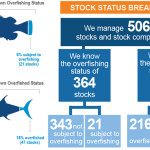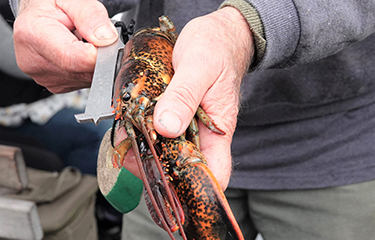The Atlantic States Marine Fisheries Commission (ASMFC) Lobster Board has delayed an increase to the lobster gauge size, triggered after lobster trawl surveys indicated a decline in sub-legal lobsters.
The size increase was triggered by Addendum 27, which the lobster board passed last May. The addendum entailed rules implementing a gauge increase in response to juvenile lobsters reaching a 35 percent decline.
The gauge size increase was initiated in 2017 as a proactive measure to improve the resiliency of lobster stock in the Gulf of Maine and Georges Bank, but was paused due to prioritized work on the North Atlantic right whales. In 2021, the addendum was revised to consider adding a trigger mechanism that measures gauge and vent size.
These proposed triggers were based on an observed abundance of lobsters with 71-80 millimeter carapace length. This would mean that the size of “keepers” for the state of Maine lobstermen would change significantly, while bordering Canadian lobstermen still get to sell the previous size allowed.
On 16 October, 2023, the Lobster Board was told that the combined index of sub-legal lobsters from surveys on trawl and ventless traps has declined by 39 percent, 4 percent more than the trigger established in the addendum.
The fact that the fishery hit the trigger so quickly came as a “significant surprise,” Maine Department of Marine Resources Commissioner Patrick Keliher said in an email. The sudden change to a larger gauge would have forced the Maine DMR and other Maine-based organizations, such as the Maine Lobstermen’s Association (MLA) and fishermen themselves, to figure out how to address inequities between the U.S. fishery and Canada.
The original timeline stated that the Addendum would implement the change on June 1, 2024. However, as requested through comments from Keliher and others, there has been a delay in the gauge increase.
“While I would have liked to have seen a one-year delay, that was not supported by the full Board. The compromise was a seven-month delay and was supported by all the States and was opposed by the National Marine Fisheries Service.” Keliher stated. The change will now be implemented on 2 January, 2025, with the first gauge increase for Lobster Management Area 1 of 1/16" to 3-5/16".
The delay in implementation will Keliher said, hopefully provide additional time for the Maine lobster fishery to work with Canadian fisheries officials on management measures that support the equity of fishermen and stock resiliency on both sides of the border. The ASMFC plans to gather more input from harvesters, dealers, and processors throughout the winter and will update the Lobster Advisory Council and Zone Council.
The primary concern raised by the MLA on the draft addendum is how the new gauge size limit could negatively impact the boat price for U.S.-caught lobster. They are concerned that Downeast Maine lobstermen will be the most affected, as they will have to throw back short lobsters that Canadian lobstermen can still catch. The MLA recommended that ASMFC conduct a study to understand the market impacts of a U.S.-only gauge increase.
Maine fishermen stand ready to adopt new rules to protect this resource, but if these lobsters can still be harvested by Canadian lobstermen and sold back to the U.S. market, there is potential that this difference will drive down the price.
“Maine lobstermen have taken seriously their responsibility to maintain a resilient lobster stock to help ensure a healthy fishery for today and future generations," MLA Policy Director Patrice McCarron said. “It must be done on a fair playing field.”
Reporting by Carli Stewart
Photo courtesy of Julia Culp/Shutterstock







